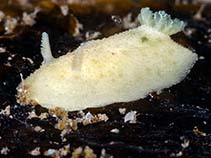Acanthodoris pilosa (Abildgaard, 1789)
Hairy spiny dorisWarning: DOMDocument::load(): SSL operation failed with code 1. OpenSSL Error messages: error:140770FC:SSL routines:SSL23_GET_SERVER_HELLO:unknown protocol in C:\Apache24\htdocs\includes\SpeciesSummary.lib.php on line 1236
Warning: DOMDocument::load(): Failed to enable crypto in C:\Apache24\htdocs\includes\SpeciesSummary.lib.php on line 1236
Warning: DOMDocument::load(https://sealifebase.nrm.se/webservice/AquaMaps/getAMap.php?genus=Acanthodoris&species=pilosa): failed to open stream: operation failed in C:\Apache24\htdocs\includes\SpeciesSummary.lib.php on line 1236
Warning: DOMDocument::load(): I/O warning : failed to load external entity "https://sealifebase.nrm.se/webservice/AquaMaps/getAMap.php?genus=Acanthodoris&species=pilosa" in C:\Apache24\htdocs\includes\SpeciesSummary.lib.php on line 1236
Classification / Names Common names | Synonyms | CoL | ITIS | WoRMS
| Nudibranchia | Onchidorididae
Environment: milieu / climate zone / depth range / distribution range Ecologia
; distribuzione batimetrica 0 - 55 m (Ref. 83435). Temperate; 85°N - 15°N, 180°W - 39°E
Distribuzione Stati | Aree FAO | Ecosystems | Presenze | Introduzioni
Atlantic Ocean, Eastern Pacific , Arctic and the Mediterranean Sea. Subtropical to polar.
Length at first maturity / Size / Peso / Age
Maturity: Lm ? range ? - ? cm Max length : 2.0 cm TL maschio/sesso non determinato; (Ref. 822)
Assumed maximum length from Ref. 822. This species is found in infralittoral areas particularly in gulfs and estuaries. It is known as an omnivore, predator and a scavenger. It feeds on planktonic and minute detrital food items through either suspension or deposit feeding (Ref. 87872).
Life cycle and mating behavior Maturità | Riproduzione | Deposizione | Uova | Fecundity | Larve
This species has separate sexes and are difficult to distinguish externally.
Main reference
Bibliografia | Coordinatore | Collaboratori
Turgeon, D.D., J.F. Quinn Jr., A.E. Bogan, E.V. Coan, F.G. Hochberg, W.G. Lyons, P.M. Mikkelsen, R.J. Neves, C.F.E. Roper, G. Rosenberg, B. Roth, A. Scheltema, F.G. Thompson, M. Vecchione and J.D. Willams. 1998. (Ref. 1667)
IUCN Red List Status (Ref. 130435)
CITES status (Ref. 108899)
Not Evaluated
CMS (Ref. 116361)
Not Evaluated
Threat to humans
Human uses
| FishSource |
Strumenti
Informazioni ulteriori
Fonti Internet
BHL | BOLD Systems | CISTI | DiscoverLife | FAO(Publication : search) | Fishipedia | GenBank (genome, nucleotide) | GloBI | Gomexsi | Google Books | Google Scholar | Google | PubMed | Tree of Life | Wikipedia (Go, ricerca) | Zoological Record
Estimates based on models
Preferred temperature
(Ref. 115969): 5.3 - 13.2, mean 9.6 (based on 636 cells).
Price category
(Ref. 80766):
Unknown.



